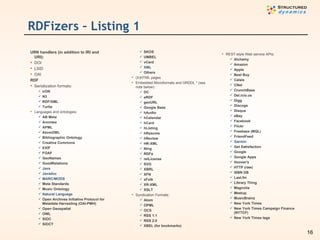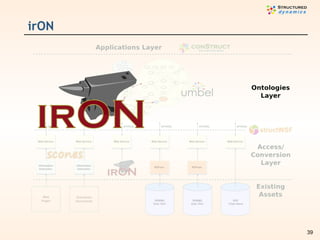Structured Dynamics' Semantic Technologies Product Stack
- 1. May (updated) 2010 Product Stack
- 3. Enterprise Approach Semantic Enterprise based on semantic Web , linked data Leverage existing assets Data, records and instances Taxonomies, structure and schema Layer semantics on to existing systems Develop incrementally Add sophistication, scope over time Keep risks low Integrate with public and Web data (“open world”)
- 4. Linked Data “ Linked Data is a set of best practices for publishing and deploying instance and class data using the RDF data model, naming the data objects using uniform resource identifiers (URIs), thereby exposing the data for access via the HTTP protocol, while emphasizing data interconnections, interrelationships and context useful to both humans and machine agents.”
- 5. Layers and Current Products
- 6. Current Products the pivotal product; Web services middleware that provides distributed data access and federation Drupal-based structured data linkage to structWSF spreadsheet, JSON and XML authoring and conversion framework reference set of linking subjects and basis for domain vocabularies an ontology- and entity-driven information extraction and tagging system
- 7. Fit of Current Products within Layers
- 9. Existing Assets These are the materials that need to be federated, made interoperable, and given a common semantics structured data / databases semi-structure data (XML, Web pages) unstructured data (text)
- 10. Preserving Existing Assets Relational databases (RDBMs) Distributed structured assets spreadsheets lightweight datastores Web pages and Web sites Existing documents and text Web databases and APIs Other databases (RDF, OO, etc.)
- 12. Conversion Provides in-place access to existing information Translates existing formats and structures to RDF Extracts structured information from unstructured text Aids creation of interoperable datasets Geared almost entirely to records , instances or entities (that is, basic data)
- 13. Conversion Methods Relational DBs: RDB2RDF RDFizers Information Extraction New Dataset Authoring Direct Use (already in RDF)
- 14. Relational DB Conversion Simple mappings of instance records to RDF Methodologies well proven if kept to the instance level RDB schema inform the interoperable layer (“ontologies”) Relational datastores left in place Record data obtained via access layer (structWSF)
- 15. RDFizers General serialization or data format conversions to RDF Mostly applied to: Standard data formats and data structs Web content APIs Some legacy content Sometimes some minor ontology or schema mapping Embodies all conversion steps to linked data We have access to more than 100+ existing formats
- 16. RDFizers – Listing 1 URN handlers (in addition to IRI and URI): DOI LSID OAI RDF Serialization formats: irON N3 RDF/XML Turtle Languages and ontologies: AB Meta Annotea APML AtomOWL Bibliographic Ontology Creative Commons EXIF FOAF GeoNames GoodRelations Java Javadoc MARC/MODS Meta Standards Music Ontology Natural Language Open Archives Initiative Protocol for Metadata Harvesting (OAI-PMH) Open Geospatial OWL SIOC SIOCT SKOS UMBEL vCard XML Others (X)HTML pages Embedded Microformats and GRDDL * (see note below): DC eRDF geoURL Google Base hAudio hCalendar hCard hListing hResume hReview HR-XML Ning RDFa relLicense SVG XBRL XFN xFolk XR-XML XSLT Syndication Formats: Atom OPML OCS RSS 1.1 RSS 2.0 XBEL (for bookmarks) REST-style Web service APIs: Alchemy Amazon Apple Best Buy Calais CNet CrunchBase Del.icio.us Digg Discogs Disqus eBay Facebook Flickr Freebase (MQL) FriendFeed Garmin Get Satisfaction Google Google Apps Hoover's HTTP (raw) ISBN DB Last.fm Library Thing Magnolia Meetup MusicBrainz New York Times New York Times Campaign Finance (NYTCF) New York Times tags
- 17. RDFizers – Listing 2 Open Library Open Social Open Street OpenLink (facets) O'Reilly Picasa Radio Pop (BBC) Rhapsody Salesforce Slideshare Slidy Technorati Tesco They Work For You Twine Twitter Weather Wikipedia World Bank Yahoo! BOSS Yahoo! Finance Yahoo! Maps Yahoo! Weather Yelp YouTube Zemanta Zillow Files (multitude of file formats and MIME types, including): audio (general) BibJSON BibTEX and others BitTorrent commON CSV Fink Flat files irJSON irXML JPEG JSON images MS Office OpenOffice Open Document Format Palm RDF123 video XLS etc. Metadata extractors: CRW DEB EXIF OCW RPM XMP Email formats: EMail Outlook RFC822 Version control and related systems: Bugzilla Jira POM Subversion Other Web service frameworks: BPEL WSDL XBRL XBEL Data exchange formats: iCalendar LDIF vCalendar vCard Relational databases and related: D2RQ D2RMAP RDF Views Virtuoso VADs OpenLink license files Third party metadata extraction frameworks: Aperture Spotlight Miscellaneous and other related converters: MPEG-7/CS -> OWL Random XSD -> OWL * GRDDL (Gleaning Resource Descriptions from Dialects of Languages) accommodates a wide variety of dialects (see one listing ) and can be combined with arbitrary transformation mechanisms (though currently mostly based on XSLTs).
- 18. scones
- 19. Information Extraction scones ( S ubject C oncept O r N amed E ntitie S ) is our IE tagger Information extraction is applied to input Web pages and unstructured text May be applied after structure extraction: (often, at minimum, defluffing ) Settable “window” for snippet (from # of bracketing terms to full document) Extraction is performed for both: Entities (per Wikipedia and enterprise dictionaries) Subject concepts (per UMBEL and domain ontologies) Presently in prototype
- 20. (Named) Entities The places , events , people , objects , and specific things of the real world Literally millions of notable instances Each belongs to one or more subject concept (s) Currently, the predominate basis for linked data Public sources include Wikipedia and Freebase, others Can be readily mixed-and-matched with private entities
- 21. Creating New Entity Dictionaries
- 23. irON – i nstance r ecord and O bject N otation
- 24. irON Dataset Authoring Framework Simple authoring and dataset creation irON includes an abstract notation and vocabulary for instance records Serializations available for: XML (irXML) JSON (irJSON) CSV/spreadsheets (commON) Notations for: Instance records Schema Datasets and metadata Linkages to other schema
- 25. Three irON Serializations irXML irJSON commON
- 27. structWSF
- 28. structWSF Generally RESTful Web services middleware Uniform, distributed access point Provides the interoperability architecture Based on canonical RDF data model Dataset access orientation Standard tools and services: User permissions and access CRUD (create, read, update, delete) Browse Full-text, faceted search Import / export Many others
- 29. RDF and Data Federation Model
- 30. Advantages of a Canonical Model All tools can be driven from a single data format basis Single converters can link in other hubs of data forms ‘ Round-tripping’ thru the canonical form can bring consistency and cleanliness to inputted data RDF is well-suited as the canonical form: Structured data Semi-structured data Unstructured data (after IE) Simple-to-complex data structures Logic and inferencing Suitable to all input data formats Many serializations possible
- 31. A Collaborative, Distributed Network
- 32. Flexible User Access Permissions
- 33. Access, APIs and Endpoints The resulting linked data may be exposed as: APIs Web services SPARQL endpoints
- 34. Ontologies Layer
- 35. Ontologies Ontologies provide the basis for: Interoperating Reconciling semantics Multiples may be used at any time Both enterprise (internal) and external ontologies Best built incrementally, with participation Easily modified: OK to test and experiment
- 36. Ontologies The structural relationships of concepts within a domain Generally class- (or set-) oriented Analogous to relational database schema, only with controlled vocabularies and exact semantics Sets the structure of how to organize the actual data (“instances”) in the domain Semantics and mapping techniques allow disparate ontologies to be inter-related Can inference or reason over the structure
- 37. Migrating Structure to the Ontology Layer
- 38. Ontologies Layer
- 39. irON
- 40. irON Record Vocabulary irON also provides the standard instance record vocabulary for all federated records Each record source has its own attributes But, irON provides common descriptors: Useful for interoperating Unique, Web-accessible identifiers Standard descriptions and labels Conventions for “driving” user interfaces and tools
- 41. UMBEL UMBEL ( U pper M apping and B inding E xchange L ayer) 20,000 defined reference points in information space Means to assert what a given chunk of content is about Enable similar content to be aggregated Place content in context with other content Aggregation points for tying in instances and entities Derived and a subset of the Cyc knowledge base Vocabulary basis for domain-specific subject ontologies
- 42. Notable Ontologies and Vocabularies
- 43. Management Layer
- 44. Management/Federation Layer Management/Federation Layer handles: Ontology mapping, management Queries and retrievals All Web services Imports and exports Inferencing and logic Ontology creation and expansion Works off of many RDF datastores Has efficient, full-text indexing with faceting Interface to the system is structWSF Can plug into many options at the Applications Layer (only Drupal with conStruct SCS yet deployed)
- 47. conStruct SCS
- 49. conStruct Capabilities Based on Drupal Single-click ( cloud ) deployment Theming User and group access and management Data display templates General content management system (CMS) Publishing RDF Open source
- 50. Re-cap
- 51. Summary Incremental, low-risk approach to the semantic enterprise Maximum leverage and re-use of existing information assets Conversion and federation of all available data forms Excellent uses for: Business intelligence Knowledge management Master data management modernization Taxonomy modernization Enterprise content integration All baseline products are open source
- 52. Contacts & Information Michael K. Bergman CEO 319.621.5225 [email_address] blog: www.mkbergman.com Steve Ardire Senior Advisor [email_address] Frédérick Giasson CTO [email_address] blog: fgiasson.com /blog Web Sites structureddynamics.com umbel.org umbel.structureddynamics.com (UMBEL Web services) citizen- dan.org (community indicator systems) openstructs.org (open source distros + documentation) constructscs.com (Drupal structured data system)
Editor's Notes
- #17: At present, though constantly increasing, Zitgist's existing conversion services recognizes nearly 100 various formats GRDDL (Gleaning Resource Descriptions from Dialects of Languages) is a W3C markup format for getting RDF data out of XML and XHTML documents using explicitly associated transformation algorithms, typically represented in XSLT GRDDL accomodates a wide variety of dialects (see one listing) and can be combined with arbitrary transformation mechanisms (though currently mostly based on XSLTs).
- #18: At present, though constantly increasing, Zitgist's existing conversion services recognizes nearly 100 various formats GRDDL (Gleaning Resource Descriptions from Dialects of Languages) is a W3C markup format for getting RDF data out of XML and XHTML documents using explicitly associated transformation algorithms, typically represented in XSLT GRDDL accomodates a wide variety of dialects (see one listing) and can be combined with arbitrary transformation mechanisms (though currently mostly based on XSLTs).
- #23: More here also, use the candidate properties content to get the extract to the SC context (??? more about the “aboutness”) contextual UMBEL metadata on the fly




















































![Contacts & Information Michael K. Bergman CEO 319.621.5225 [email_address] blog: www.mkbergman.com Steve Ardire Senior Advisor [email_address] Frédérick Giasson CTO [email_address] blog: fgiasson.com /blog Web Sites structureddynamics.com umbel.org umbel.structureddynamics.com (UMBEL Web services) citizen- dan.org (community indicator systems) openstructs.org (open source distros + documentation) constructscs.com (Drupal structured data system)](https://image.slidesharecdn.com/sdproductstack20091102-091102163620-phpapp01/85/Structured-Dynamics-Semantic-Technologies-Product-Stack-52-320.jpg)
